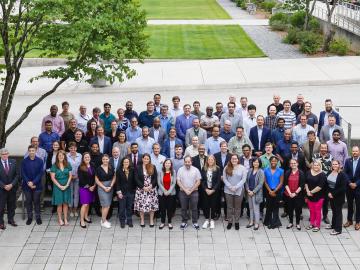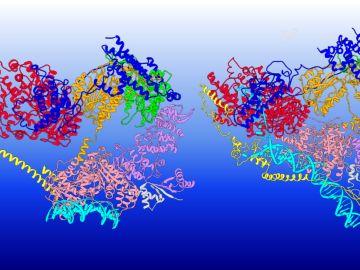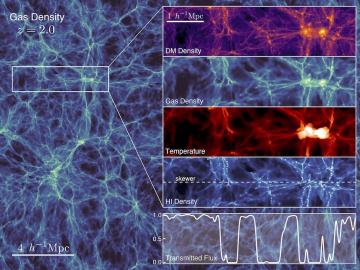
Filter News
Area of Research
- (-) National Security (45)
- (-) Supercomputing (153)
- (-) Transportation Systems (4)
- Advanced Manufacturing (5)
- Biological Systems (1)
- Biology and Environment (102)
- Biology and Soft Matter (4)
- Building Technologies (2)
- Chemical and Engineering Materials (3)
- Chemistry and Physics at Interfaces (7)
- Clean Energy (168)
- Climate and Environmental Systems (7)
- Computational Biology (1)
- Computational Chemistry (5)
- Computational Engineering (1)
- Computer Science (3)
- Data (1)
- Earth Sciences (1)
- Electricity and Smart Grid (1)
- Energy Frontier Research Centers (7)
- Fuel Cycle Science and Technology (2)
- Functional Materials for Energy (8)
- Fusion and Fission (32)
- Fusion Energy (7)
- Geographic Information Science and Technology (1)
- Isotopes (21)
- Materials (122)
- Materials for Computing (13)
- Materials Synthesis from Atoms to Systems (8)
- Materials Under Extremes (7)
- Neutron Data Analysis and Visualization (2)
- Neutron Science (72)
- Nuclear Science and Technology (27)
- Quantum Condensed Matter (3)
- Quantum information Science (4)
- Renewable Energy (2)
- Sensors and Controls (2)
News Type
News Topics
- 3-D Printing/Advanced Manufacturing (3)
- Artificial Intelligence (25)
- Big Data (15)
- Bioenergy (4)
- Biology (8)
- Biomedical (7)
- Biotechnology (2)
- Buildings (2)
- Chemical Sciences (1)
- Climate Change (15)
- Computer Science (49)
- Coronavirus (8)
- Cybersecurity (8)
- Decarbonization (4)
- Energy Storage (1)
- Environment (16)
- Exascale Computing (12)
- Frontier (13)
- Grid (4)
- High-Performance Computing (22)
- Machine Learning (13)
- Materials (5)
- Materials Science (9)
- Mathematics (1)
- Microscopy (2)
- Nanotechnology (5)
- National Security (23)
- Net Zero (1)
- Neutron Science (7)
- Nuclear Energy (3)
- Physics (3)
- Quantum Computing (10)
- Quantum Science (11)
- Security (6)
- Simulation (10)
- Software (1)
- Space Exploration (1)
- Summit (21)
- Sustainable Energy (3)
- Transportation (3)
Media Contacts

When geoinformatics engineering researchers at the Department of Energy’s Oak Ridge National Laboratory wanted to better understand changes in land areas and points of interest around the world, they turned to the locals — their data, at least.

Experts across varied technology fields gathered ORNL to collaborate on the future of geospatial systems at the Trillion-Pixel GeoAI Challenge workshop. The third iteration of this event focused on multimodal advances in the field, including progress in artificial intelligence, cloud infrastructure, high-performance computing and remote sensing. These capabilities, when combined, can help solve problems in national and human security such as disaster response and land-use planning.

Over the past decade, teams of engineers, chemists and biologists have analyzed the physical and chemical properties of cicada wings, hoping to unlock the secret of their ability to kill microbes on contact. If this function of nature can be replicated by science, it may lead to products with inherently antibacterial surfaces that are more effective than current chemical treatments.

As extreme weather devastates communities worldwide, scientists are using modeling and simulation to understand how climate change impacts the frequency and intensity of these events. Although long-term climate projections and models are important, they are less helpful for short-term prediction of extreme weather that may rapidly displace thousands of people or require emergency aid.

Transcription factor IIH is a veritable workhorse among the protein complexes that regulate human cell activity, playing critical roles both in synthesizing DNA and in enabling DNA repair. But how can one protein assembly participate in two such vastly different jobs? A team of researchers led by chemistry professor Ivaylo Ivanov of Georgia State University used the Summit supercomputer at ORNL to tackle that question.

A research team from the University of California, Santa Cruz, have used the Oak Ridge Leadership Computing Facility’s Summit supercomputer to run one of the most complete cosmological models yet to probe the properties of dark matter.

With the world’s first exascale supercomputer now fully open for scientific business, researchers can thank the early users who helped get the machine up to speed.

Tristen Mullins enjoys the hidden side of computers. As a signals processing engineer for ORNL, she tries to uncover information hidden in components used on the nation’s power grid — information that may be susceptible to cyberattacks.

As a result of largescale 3D supernova simulations conducted on the Oak Ridge Leadership Computing Facility’s Summit supercomputer by researchers from the University of Tennessee and Oak Ridge National Laboratory, astrophysicists now have the most complete picture yet of what gravitational waves from exploding stars look like.

To support the development of a revolutionary new open fan engine architecture for the future of flight, GE Aerospace has run simulations using the world’s fastest supercomputer capable of crunching data in excess of exascale speed, or more than a quintillion calculations per second.


